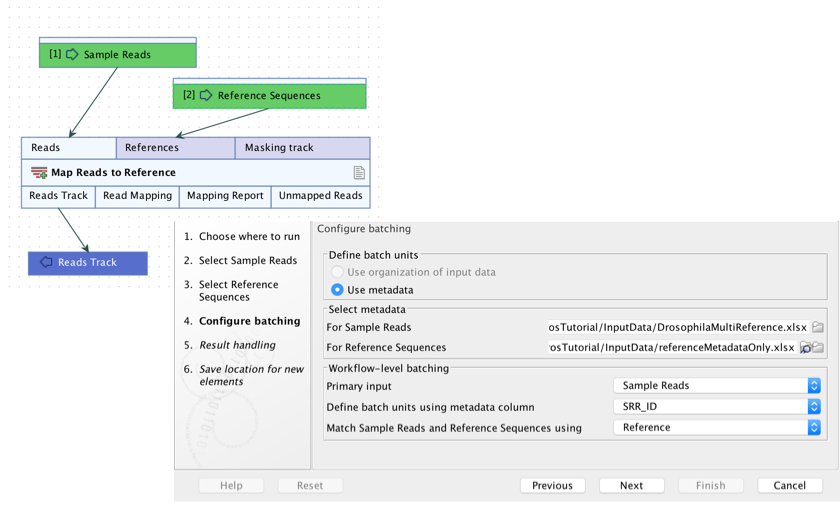Batching workflows with more than one input changing per run
When a workflow contains multiple Input elements (multiple light green boxes),
A Batch checkbox is available in the launch wizard for each Input element attached to a main input channel.
Checking that box indicates that the data supplied for that input should change in each batch run.
By contrast, if multiple elements are selected, and the Batch option is not checked, all elements will be treated a single set, to be used in a single analysis run.
Most commonly, one input is changed per run. For example, in a batch analysis involving read mappings, usually each batch unit would include a different set of reads, but the same reference sequence.
However, it is possible to have two or more inputs that are different in each batch unit. For example, an analysis involving a read mapping, where each set of reads should be mapped to a different reference sequence. In cases like this, batch units must be defined using metadata.
Figure 14.88 shown an example where the aim is to do just this. The workflow contains a Map Reads to Contigs element and two workflow input elements, Sample Reads and Reference Sequences. The information to define the batch units is provided by two Excel files, one containing information about the Sample Reads input and the other with information about the Reference Sequences input. The contents of files that would work for this example are shown in figure 14.89.
Of particular note are:
- The first column of file contains the exact file names for all data for that input, across all of the batch runs.
- At least one column in each file has the same name as a column in the other file. That column should contain the information needed to match the input data, in this case, the Sample Reads input data with the relevant Reference Sequences input data for each batch unit.

Figure 14.88: A workflow with 2 inputs, where the Batch checkbox had been checked for both in the relevant launch steps. Metadata is used to define the batch units since the correct inputs must be matched together for each run.

Figure 14.89: Two Excel files containing information about the data for each batch unit for the workflow shown in figure 14.88. With the settings selected there, the number of batch runs will be based on the Sample Reads input, and will equal the number of unique SRR_ID entries in the DrosophilaMultiReference.xlsx file. The correct reference sequence to map to is determined by matching information in the Reference column of each Excel file.
In the Workflow-level batching section of the launch wizard, the following are specified:
- The primary input. The input that determines the number of times the workflow should be run.
- The column in the metadata for the primary input that specifies the group the data belongs to. Each group makes up a single batch unit.
- The column in both metadata files that together will be used to ensure that the correct data from each workflow input are included together in a given batch run. For example, a given set of sample reads will be mapped to the correct reference sequence. A column with this name must be present in each metadata file or table.
In figure 14.88, Sample Reads is the primary input: We wish to run the workflow once for each sample, which here, is once for each SRR_ID entry. The Reference sequence to use for each of these batch units is defined in a column called Reference, which is present in both the file containing information about the samples and the file containing information about the references.
